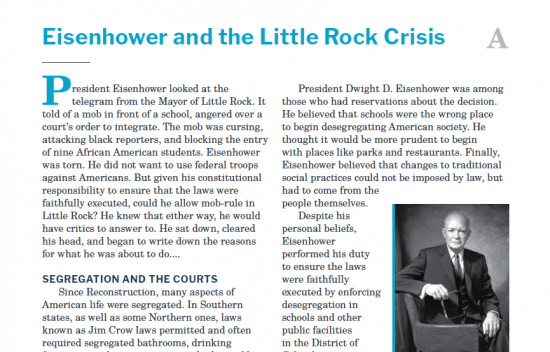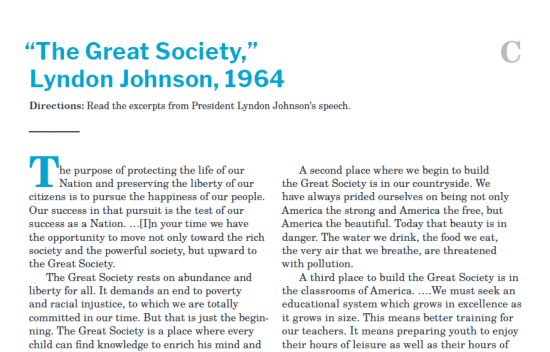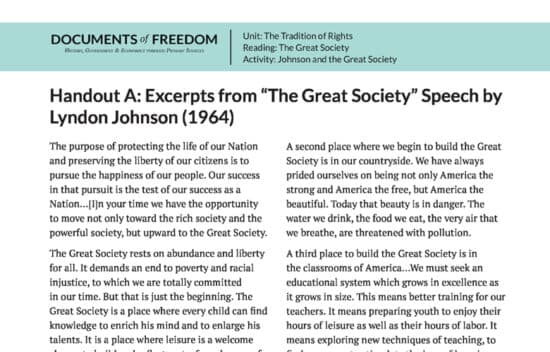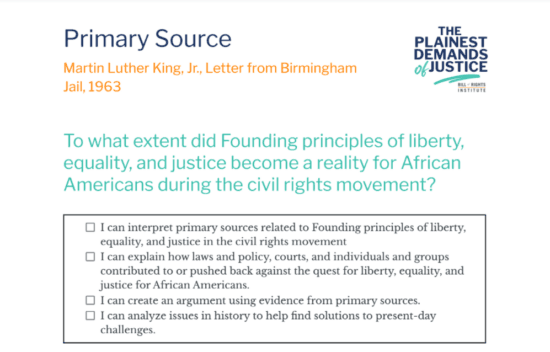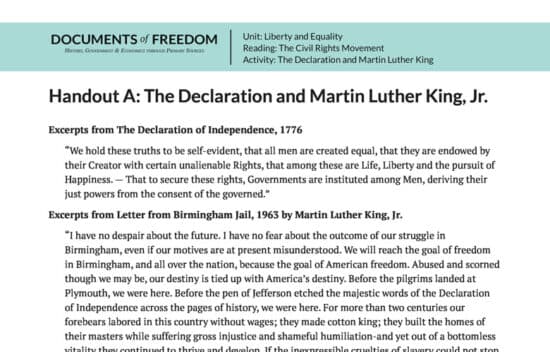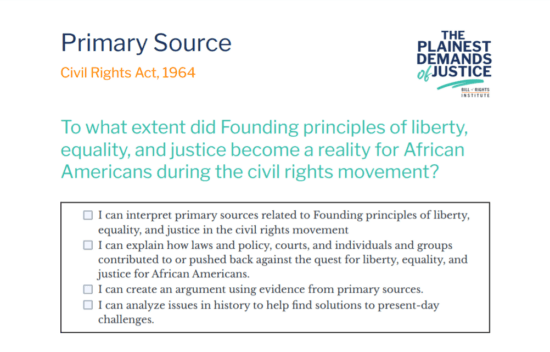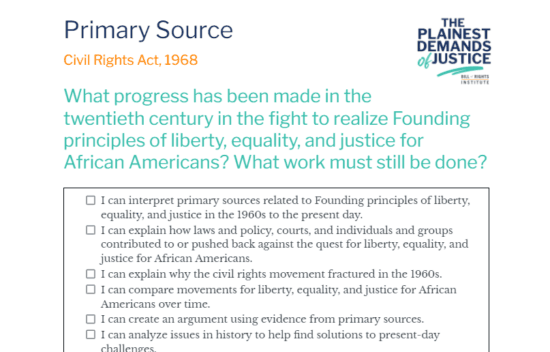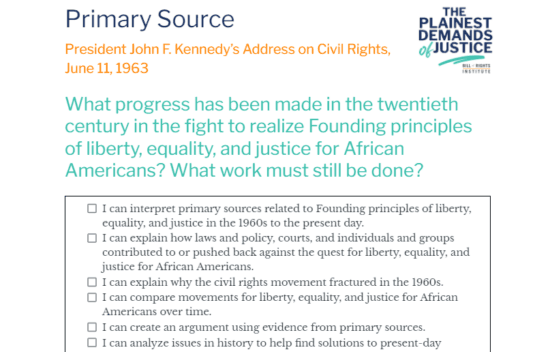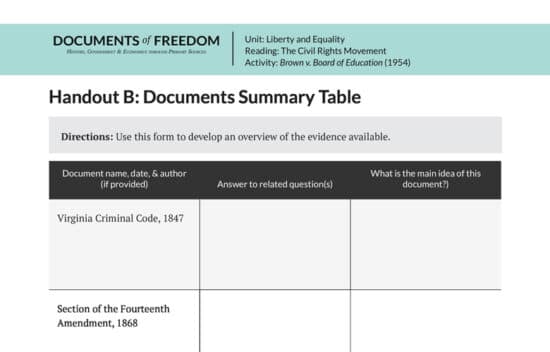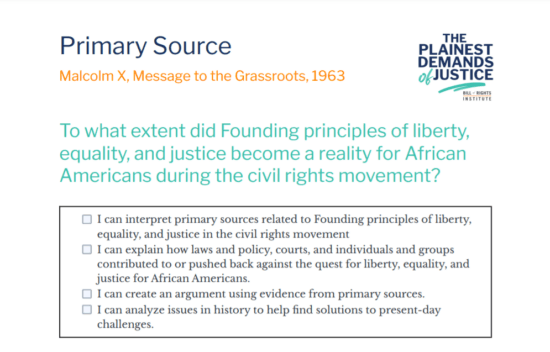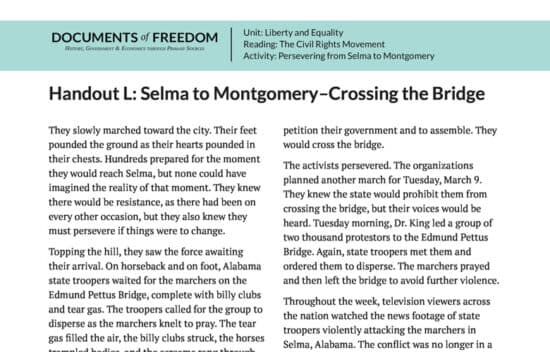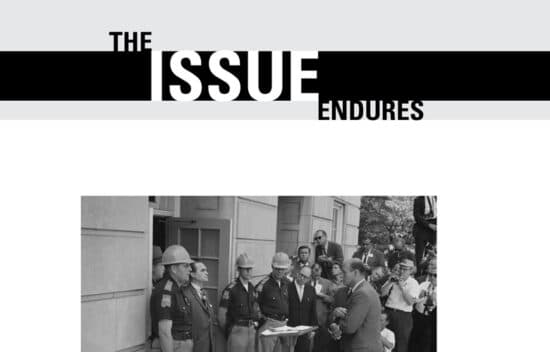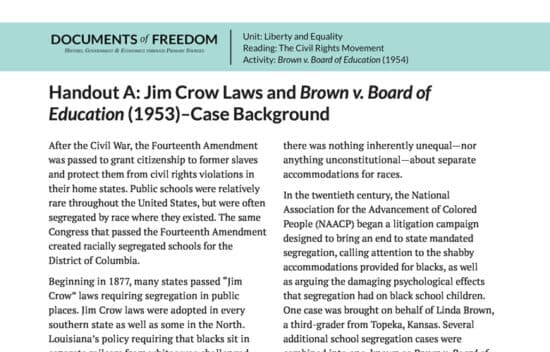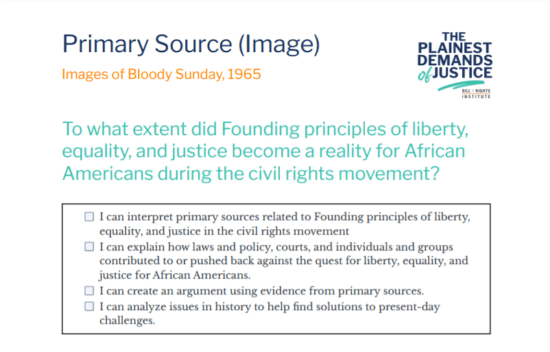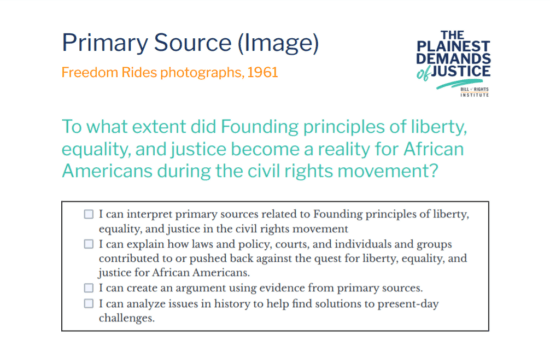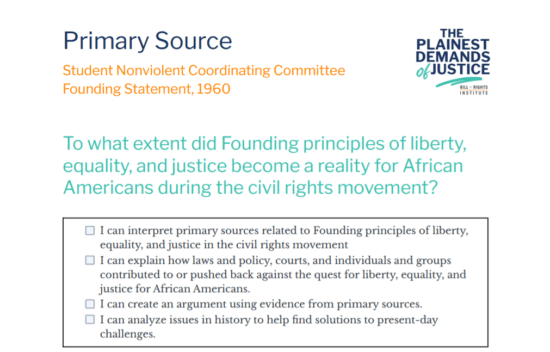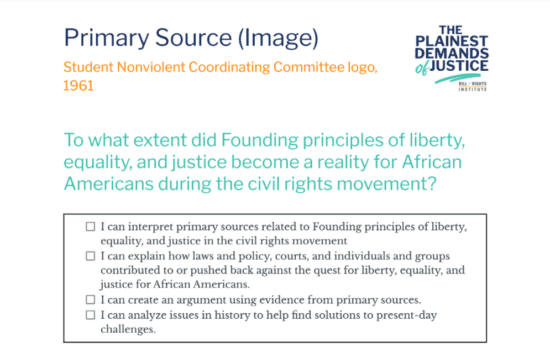



Civil Rights Movement Playlist
71 items

Letter from Birmingham Jail
Primary Source - 2109 Words
Primary Source
2109 Words
Excerpts of Letter from Birmingham Jail
Dr. Martin Luther King, Jr.
April 16, 1963
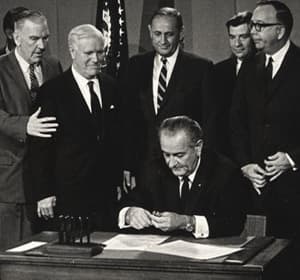
Was the Great Society Successful?
Activity
Activity
40 Min
Did the Great Society significantly alleviate poverty and social ills in the United States or did it have little impact beyond creating unsustainably expensive federal programs? Anthony D. Bartl and Gregory L. Schneider debate this question.
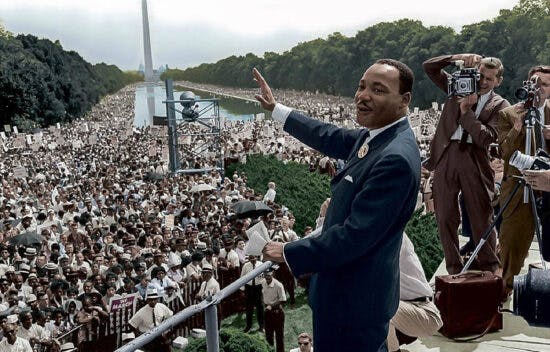
Martin Luther King Jr., “I Have a Dream,” August 28, 1963
Activity
Activity
40 Min
Use this primary source text to explore key historical events.

Malcolm X, “The Ballot or the Bullet,” April 12, 1964
Activity
Activity
40 Min
Use this primary source text to explore key historical events.
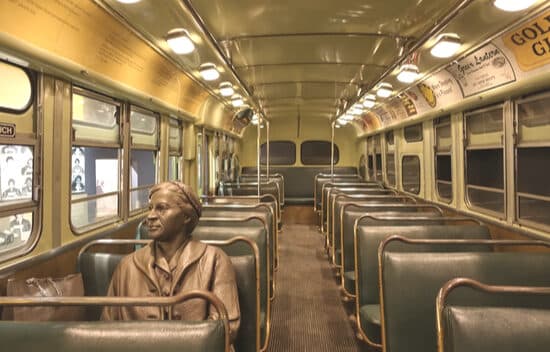
Rosa Parks’s Account of the Montgomery Bus Boycott (Radio Interview), April 1956
Activity
Activity
40 Min
Use this primary source text to explore key historical events.

Elizabeth Eckford and Courage: Heroes & Villains
Video
Video
3 Min
Why is individual courage necessary for the success of the larger community or civil society? Explore the story of Elizabeth Eckford in this video feature of BRI's Heroes and Villains Curriculum to help determine how she exhibited the virtue of courage.
Heroes and Villains uses narratives to discuss the concepts of civic virtue in all classrooms. Each virtue narrative includes corresponding discussion guides, journal templates, a toolbox with additional activities, and suggestions for further reading on each topic or virtue.
3 Min

Brown v. Board of Education | BRI’s Homework Help Series
Video
Video
4 Min
Brown v Board of Education was a case brought to the Supreme Court in 1954 after Linda Brown, an African American student in Kansas, was denied access to the white-only schools nearby her house. Future Supreme Court Justice Thurgood Marshall was the lawyer for the case, and argued that segregated schools were inherently unequal. Ultimately, the Supreme Court ruled in favor of Linda Brown and declared segregation unconstitutional under the Equal Protection Clause of the 14th Amendment through incorporation under the premise that the bill of rights also applies to the states. This is one of the landmark cases that led to the passage of the Civil Rights Act of 1964.
4 Min

Martin Luther King Jr. and The March on Washington to the Lincoln Memorial | BRIdge from the Past
Video
Video
10 Min
What significance did the Lincoln Memorial have to the March on Washington? In this episode of BRIdge from the Past, Mary examines images of the 1963 March on Washington for Jobs and Freedom. The massive march of over 250,000 people culminated at the Lincoln Memorial where Martin Luther King Jr delivered his “I Have A Dream” speech. How did King use American Founding documents to highlight the meaning of equality in his speech? How was this event similar and different to others that have taken place at the Lincoln Memorial over American history?
10 Min

Reading Martin Luther King Jr’s “Letter From a Birmingham Jail” | A Primary Source Close Read
Video
Video
42 Min
How do you find the strength to stand up for what you believe in? In this Primary Close Read video, Kirk and Rachel are joined by Dr. Anika Prather, Professor in the Classics Department at Howard University and founder of The Living Water School, to read Martin Luther King, Jr's "Letter From a Birmingham Jail." They explore the ways King planned to right the wrongs of injustice, and how he urged others to act. How does King's letter convey hope for the American story?
42 Min

Martin Luther King Jr.’s Dedication to Equality and Justice with Jonathan Eig | BRI Scholar Talks
Video
Video
14 Min
How did Martin Luther King, Jr. dedicate his life to equality and justice? In this episode of Scholar Talks, BRI Senior Fellow Tony Williams is joined by award-winning author and journalist Jonathan Eig to discuss his newest book, New York Times bestseller ‘King: A Life.’ Together, they touch on topics such as King’s background, leadership, courage, and complex relationships with rising young activists.
14 Min

Calling For Change: Violence or Nonviolence? Images of Bloody Sunday, 1965
Video
Video
11 Min
Which is more effective in calling for change and pursuing the virtue of justice: violence or nonviolence? In this episode of BRIdge from the Past, Mary examines images from Bloody Sunday in Selma, Alabama in 1965 and the 54-mile march organized by activist groups in their pursuit of civil rights and justice for all. What lessons can be learned from these images of peaceful protest and violent opposition? What do they reveal about effective ways to pursue justice in America today?
11 Min

Freedom Riders
Essay - 2752 Words
Essay
2752 Words
How did the Freedom Riders fight to end segregation?

Sports, Protest, and Civil Rights: John Carlos and Tommie Smith at the 1968 Olympics
Video
Video
11 Min
What controversy arose around this image from the 1968 Olympics? In this episode of BRIdge from the Past, Mary explores the image of John Carlos and Tommie Smith and the statement they made during the Mexico City Olympics. What historical events occurred around this time that led to their protest? What lessons can we learn about protests today from examining this image?
11 Min

Freedom of Assembly Clause: Edwards v. South Carolina Case Excerpts
Video
Video
15 Min
The First and Fourteenth Amendments protect assembly, but what kind of assembly are they referring to? To explore this question Josh Schmid is joined by Dr. Joshua Dunn as they explore the Supreme Court Case of Edwards v. South Carolina, which questioned whether government officials had a right to force a peaceful protest to disperse. What impact does this case have in the modern day?
15 Min

The Free Speech Clause: Brandenburg v. Ohio Case Excerpts | A Primary Source Close Read w/ BRI
Video
Video
19 Min
Can the government stop speech that advocates illegal activities? In this Close Read, Josh Schmid is joined by Josh Dunn, Professor of Political Science at the University of Colorado, to see how the Supreme Court case of Brandenburg v. Ohio answered this question. What impact does this case have on modern day free speech cases?
19 Min
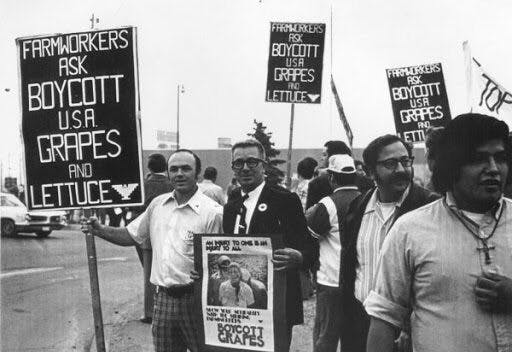
Art as Protest: Images from the United Farm Workers of America, 1973–1978
Activity
Activity
40 Min
Use this primary source imagery to analyze major events in history.

The Art of Protest: The United Farm Workers and the Delano Grape Strike | BRIdge from the Past
Video
Video
11 Min
What do images tell us about the role of protest in creating change? Using the logo for the United Farm Workers as a point of departure, Mary explores one of the most famous strikes in U.S. history, the Delano Grape Strike.
11 Min
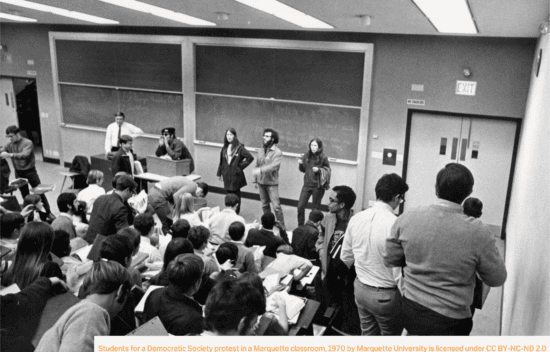
Students for a Democratic Society, “Port Huron Statement,” 1962
Activity
Activity
40 Min
Use this primary source text to explore key historical events.

Reading the “Port Huron Statement” | A Primary Source Close Read w/ BRI
Video
Video
31 Min
While Americans today might have a rosy view of the 60s, not everyone living during that time saw it that way. On issues ranging from the Cold War to civil rights, a group of students called “the Students for a Democratic Society” offered their critique of society at large on June 15, 1962. In this video, Kirk Higgins and Joshua Schmid explore the topics addressed in the “Port Huron Statement.” What were the primary concerns that the “New Left” thought America could improve on? Do these criticisms still hold true today and if so how?
31 Min

The Baldwin-Buckley Debate with Nicholas Buccola | BRI Scholar Talks
Video
Video
38 Min
What timeless messages does the Baldwin-Buckley Debate teach about the discussion of race in the 1960s? In this Scholar Talk video, BRI Senior Teaching Fellow Tony Williams sits down with Nicholas Buccola, writer and expert in American political thought, to discuss Buccola's new book, "The Fire is Upon Us: James Baldwin, William F. Buckley Jr., and the Debate Over Race in America." Buccola delves into the backgrounds of both James Baldwin, the foremost literary voice of the civil rights movement, and William F. Buckley Jr., one of America's most influential conservatives and opponent of the civil rights movement, to describe their radically different views on the racial divide in America. How far have we come from this moment in 1965, and what work lies ahead of us in pursuit of true equality for all?
38 Min

Baker v. Carr | Homework Help from the Bill of Rights
Video
Video
5 Min
In this Homework Help video, learn the story of the landmark Supreme Court case of Baker v. Carr. The case explores the question of a state’s right to control electoral lines otherwise known as gerrymandering.
The case ruling concluded that the Supreme Court could hear cases pertaining to redistricting because of the Equal Protection Clause in the 14th Amendment through the process of incorporation which argues that states must adhere to the protections of guaranteed in the Bill of Rights. How did the ruling in this case contribute to the democratic principle of “one person-one vote”?
5 Min

Equal Protection and Affirmative Action Essay – Regents of the University of California v. Bakke (1978)
Activity
Activity
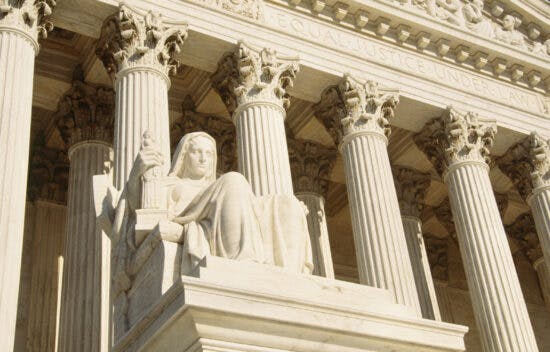
Regents of the University of California v. Bakke (1978)
Lesson - 4 Activities
Lesson
4 Activities
Case background and primary source documents concerning the Supreme Court case of Regents of the University of California v. Bakke. Dealing with the principle of Equal Protection and affirmative action, this lesson asks students to asses whether or not the University of California at Davis's special admissions program resulted in unconstitutional reverse discrimination.
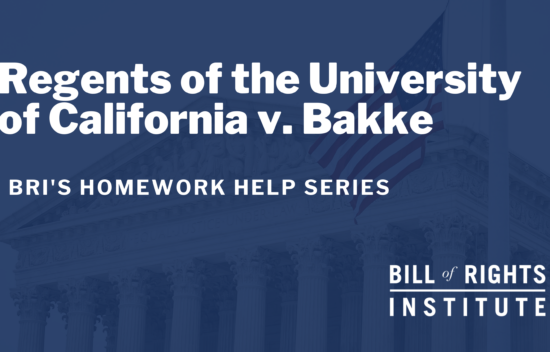
Regents of the University of California v. Bakke | BRI’s Homework Help Series
Video
Video
4 Min
Regents of the University of California v. Bakke was a case brought to the Supreme Court over the use of Affirmative Action in the college admission process. The University of California at Davis Medical School created a minimum minority student quota for the admissions department to fill each year. Bakke, a two-time UC-Davis Med School rejected applicant, sued the school for violation of the Equal Protection Clause of the 14th Amendment and Title VI of the Civil Rights Acts. Ultimately, the Supreme Court justices ruled in support of the goals of Affirmative Action because of incorporation, the idea that the states must adhere to the protections of the Bill of Rights. They also stated that Bakke was, in fact, denied equal protection. This decision, because it was so muddled, did not set long-term precedents or clarifications concerning Affirmative Action.
What is Affirmative Action? Affirmative Action is a policy, usually carried out by schools, businesses, government entities, and federal contractors, in which individuals of minority racial status are afforded preferential treatment on the basis of race. Affirmative action came about as part of a desire to rectify the traditional underrepresentation of minority peoples in desirable professions and universities, which negatively impacted their financial and social conditions.
4 Min
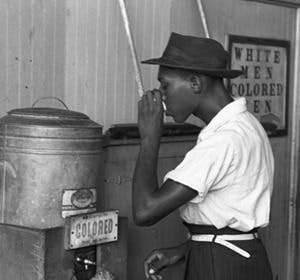
Essay: The Civil Rights Movement
Essay - 2314 Words
Essay
2314 Words
The Civil Rights Movement sought to win the American promise of liberty and equality during twentieth-century America. From the early struggles of the 1940s to the crowning successes of the Civil Rights and Voting Rights Acts that changed the legal status of African-Americans in the United States, the Civil Rights Movement firmly grounded its appeals for liberty and equality in the Constitution and Declaration of Independence. Rather than rejecting an America that discriminated against a particular race, the movement fought for America to fulfill its own universal promise that "all men are created equal." It worked for American principles within American institutions rather than against them.

Civil Rights DBQ
Lesson
Lesson
Use this lesson with the Freedom Riders Narrative; The March on Birmingham Narrative; the Black Power Narrative; the Martin Luther King Jr., "Letter from Birmingham Jail," 1963 Primary Source; the Martin Luther King Jr., "I Have a Dream," August 28, 1963 Primary Source; the Civil Disobedience across Time Lesson; and The Music of the Civil Rights Movement Lesson to discuss the different aspects of the civil rights movement during the 1960s.

The Civil Rights Movement
Lesson - 15 Activities
Lesson
15 Activities
90 Min
The Civil Rights Movement sought to win the American promise of liberty and equality during the twentieth-century. From the early struggles of the 1940s to the crowning successes of the Civil Rights and Voting Rights Acts that changed the legal status of African-Americans in the United States, the Civil Rights Movement firmly grounded its appeals for liberty and equality in the Constitution and Declaration of Independence. Rather than rejecting an America that discriminated against a particular race, the movement fought for America to fulfill its own universal promise that “all men are created equal.” The Civil Rights Movement worked for American principles within American institutions rather than against them.
90 Min

Continuing the Heroic Struggle for Equality – The Civil Rights Movement
Lesson - 23 Activities
Lesson
23 Activities
90 Min
To what extent did Founding principles of liberty, equality, and justice become a reality for African Americans in the civil rights movement? The documents come from a variety of actors: legislators and policy makers, the courts, and individuals and groups. As students go through the documents, encourage them not only to think about the principles of liberty, equality, and justice, but also about the way in which these groups interact with each other in creating or stalling change.
90 Min
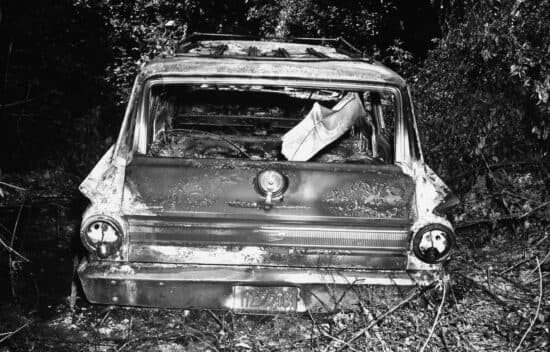
A Civil Rights Investigation: Mississippi Burning
Lesson
Lesson
Why did three civil rights workers disappear during the Freedom Summer of 1964? Engage students with primary source documents to investigate this question. This lesson was developed by and included with the permission the LBJ Presidential Library.
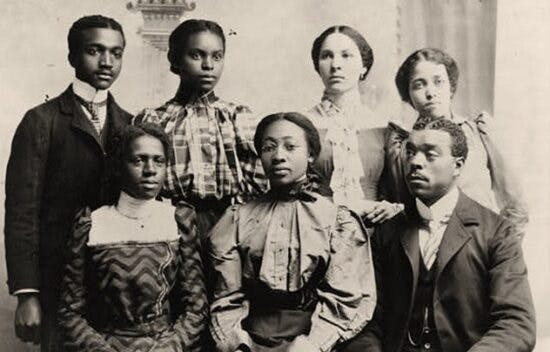
Unit 5 Civics Connection: Civil Rights and Economic Freedom
Lesson - 1 Activities
Lesson
1 Activities
80 Min
A review lesson for Unit 5 (1877-1898) that asks students to reconsider how constitutional principles were applied during the time period.
80 Min
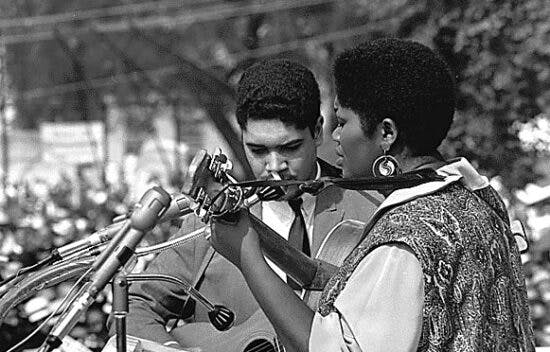
The Music of the Civil Rights Movement
Lesson
Lesson
Use this lesson with the Freedom Riders Narrative; The March on Birmingham Narrative; the Black Power Narrative; the Martin Luther King Jr., "Letter from Birmingham Jail," 1963 Primary Source; the Martin Luther King Jr., "I Have a Dream," August 28, 1963 Primary Source; the Civil Disobedience across Time Lesson; and the Civil Rights DBQ Lesson to discuss the different aspects of the civil rights movement during the 1960s.

Female Leadership Behind the Scenes: Ella Baker and the Civil Rights Movement
Video
Video
9 Min
How did Ella Baker contribute to the civil rights movement? In this episode of BRIdge from the Past, Mary examines Ella Baker’s work cultivating strong leaders in the fight for equality and how the Freedom School mural portrays her story. How did Baker believe movements for change should be organized and run? What do her contributions teach us about being a good leader?
9 Min

Peter C. Myers: Civil Rights & Civil Disobedience | BRI Scholar Talks
Video
Video
54 Min
BRI Senior Teaching Fellow Tony Williams sits down with Peter C. Myers, professor of political science specializing in political philosophy and U.S. constitutional law at the University of Wisconsin-Eau Claire, to discuss Peter's compelling essay in Life, Liberty, and the Pursuit of Happiness on Martin Luther King, Jr., and the Birmingham March. Integrating material on constitutional principles and injustice of segregation including the Letter from Birmingham Jail and the I Have a Dream speech, they draw out the gripping and important story of civil rights and explain the ways it will interest students.
54 Min
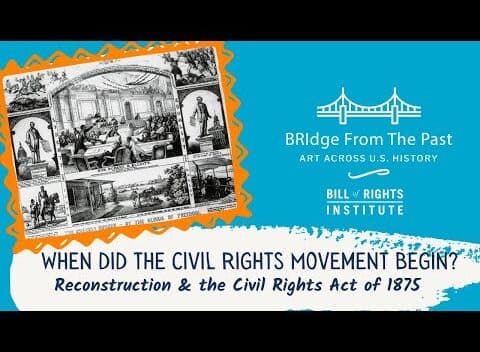
When Did the Civil Rights Movement Begin? Reconstruction & the Civil Rights Act of 1875
Video
Video
11 Min
Today, Mary looks at an image from the Reconstruction era that challenges us to reconsider what we mean when we say “the civil rights movement.” Typically, if someone says, "Civil Rights Movement," we think of the 1950s and 1960s, but does the story go back further? Similarly, if someone mentions “the civil rights act” we think of the landmark legislation in the Civil Rights Act of 1964. But this isn’t the only civil rights act to date nor is it the first.
Explore the 13th Amendment, 14th Amendment, and 15th Amendment (Reconstruction Amendments), the Civil Rights Act of 1875, and other primary sources surrounding the era or reconstruction and the continuous work to achieve civil rights for black Americans.
11 Min

We are not Afraid and We Shall Overcome: The Freedom Rides and Courage
Lesson - 1 Activities
Lesson
1 Activities
45 Min
How did the Freedom Riders in the early days of the 1960s Civil Rights movement display courage? How can students act courageously in their own lives?
45 Min
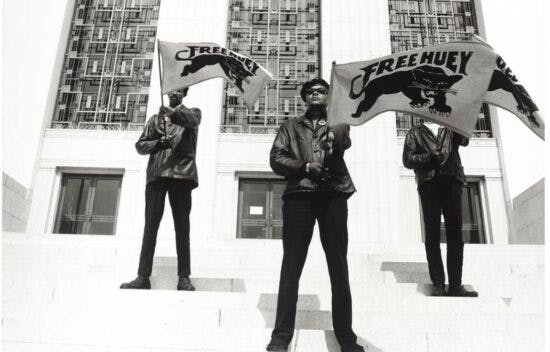
Black Power
Essay - 2570 Words
Essay
2570 Words
Explores the impact of the Black Power movement in the 1960s.

Stokely Carmichael and Charles Hamilton, Black Power: The Politics of Liberation in America, 1967
Activity
Activity

The Controversy over Busing
Essay - 2436 Words
Essay
2436 Words
How did cities attempt to integrate schools in the 1970s?
